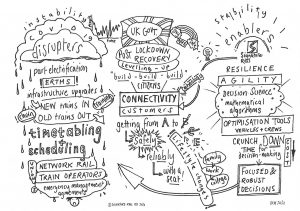Dubbed “AI on steroids”, Decision Science is already changing the world. Now it’s coming to rail.
Over the past twenty years a digital revolution has transformed the way we work, shop and communicate. But if the changes so far seem radical, what comes next is likely to eclipse them, because technology is no longer merely affecting how we interact; it is changing how we make decisions.
While the power of data and tools wielded by social and retail giants such as Google and Amazon is largely well understood, in reality Decision Science is already a vital tool across a wide range of sectors, where widespread use of data is making established processes exponentially more efficient.
Ali Khatam, co-founder of Decision Science specialists QAMPO, describes the discipline as having two parts – mindset and technology: “It is crucial to develop solutions which people act upon so we can track when and how decisions are made, and how to apply intelligence. However, this only works if people act on your data – if they don’t act, you can’t calibrate. So, it’s about availability, use and measurement.”
Ali explains that when it comes to technology, prediction and prescription are vital. “You have to know the probability of an action – you then have a window in which to act. If you don’t use this window, the data is just a report”. In other words, it is the action informed by data that holds the true value: “When you combine decision support on top of data, it is possible to see which of the available options is best. This is the true power of Decision Science.”
The Role of Decision Science in Rail Planning
The power of Decision Science is in its ability to make sense of complexity. This is a discipline well suited to rail planning, where the vast number of outcomes can often be overwhelming.
As outlined in an article by the Global Railway Review, “big data analytics have the potential to influence several dimensions of the railway sector and can overcome organisational, operational and technical complexities, including economic and human effects and information handling.”
With modern rail planning, complexity levels are already way beyond what humans can realistically expect to manage. However, the ability to identify the best approach is something that an algorithm cannot do on its own. The answer, therefore, is to align technology and expertise in order to improve decision making.
Essentially, the task is to augment human expertise with the power of algorithms, empowering experts to test countless scenarios to find optimal solutions. This is the goal of Decision Science, and there is an increasing belief that it is set to transform the way we live and work.
Decision Science informs rail planning in three distinct ways: visibility, ‘what if’ planning, and “what next” planning. Let’s take a look at each.
Visibility: The Foundation for Decision Science
Visibility plays a critical part in decision making: it is the layer of information on which future decisions are based. In short, if you don’t have visibility of key data you cannot hope to make effective decisions.
The baseline for effective decision making is an accurate understanding of all crew, vehicle and mileage costs. Together this data can help operators to understand their present productivity level – a measure of crew and vehicles costs in comparison with non-productive time.
Having this data validated and readily available provides assurance – and constitutes the first step in the decision-making process.
Increasing Efficiency With ‘What If’ Planning
Decision Science has the potential for a truly game changing impact on the efficiency of rail planning. This notoriously complex process can be simplified to such an extent that Ali Khatam likens it to a videogame ‘God Mode’: “Think of rail planning as a game of Tetris,” he says. “With Decision Science it’s like playing while being able to predict the next thousand pieces. It’s a lot easier to minimise the gaps when you can see the entire picture.”
The move towards Decision Science in rail is being driven by two requirements: winning tenders and operating efficiently.
As Antony Chilton-Murphy, Director of Business Development at Signature Rail explains, “Rail planning is about big decisions. Anyone can bid low to win a tender; the challenge is winning with the right bid. You need data to inform these kinds of decisions.” With Decision Science, operators can analyse all available data in order to accurately predict operations, and use this information to understand the profitability of a particular route.
The process here revolves around understanding the operator’s problem, and then transforming it into an algorithm, thereby making it possible to remove the complexity. To achieve this, relevant ‘levers’ (factors that can be adjusted) are identified, and handed to the operator’s planning team to implement. Typical considerations (‘what if’ scenarios) might include: What if I hire more drivers? What if I buy more vehicles? What if I move my depot to a different location?
The results of these hypothetical scenarios are then presented in relation to the identified purpose – usually revenue and cost – thereby empowering customers to make complex problems simple and transparent. Thus armed, the business can then bid for the tender at a level that they know they can deliver upon, ensuring the best combination of competitiveness, reduced risk, and profitability.
A Better Tomorrow: ‘What Next’ Planning
As incredible as the potential for ‘What If’ planning is, perhaps the most impressive element is that we are just at the beginning of this journey. As Ali Khatam explains, this is an immature technology: “Machine learning and optimisation are becoming mature, but Decision Science – the alignment of the two – is still in its infancy.”
Looking ahead, Decision Science is set to play a huge role in rail, moving from mere ‘what if’ planning to ‘what next’. Essentially, technology will no longer just optimise what we do; it will be tell us what to do.
Decision Science will completely transform operators’ ability to make informed decision. A range of forward-looking factors, including changes either strategic (government or economic policy), tactical (new lines and stations) or operational (response to disruption) will dynamically inform all aspects of decision making, ultimately ensuring optimal operational efficiency and a level of customer experience that drives ridership.
The role of organisations like Signature Rail is to embrace the opportunity to work with specialist partners such as Qampo, who can help our customers to achieve transformative results with this new technology.
Together we are now beginning to collate and integrate all relevant data, making it available, visualised, and simple to act upon. In the longer term this process will enable operators to understand and respond to future trends, validating investment plans in-line with accurately anticipated demand – thereby maximising revenue to facilitate profitability and future growth.
Conclusion
It is difficult to understate the level of change promised by Decision Science. Ali Khatam describes it as “AI on steroids”, pointing to the DeepMind’s AI, which “doesn’t play chess like a machine – it plays it like a human grandmaster, but better.”
We are headed for a brave new world – one in which Decision Science is set to transform every aspect of rail operation. For all of us in the industry the challenge now is to utilise this technology as early as possible, finding ways to improve operations and profitability, and delivering services that meet customer need as safely, reliably and sustainably as possible.
We will all – operators, infrastructure organisations and suppliers – need to work together to deliver on the promise of this new technology for the benefit of all. So if you are ready to take the next step then please get in touch and let’s take it together.


